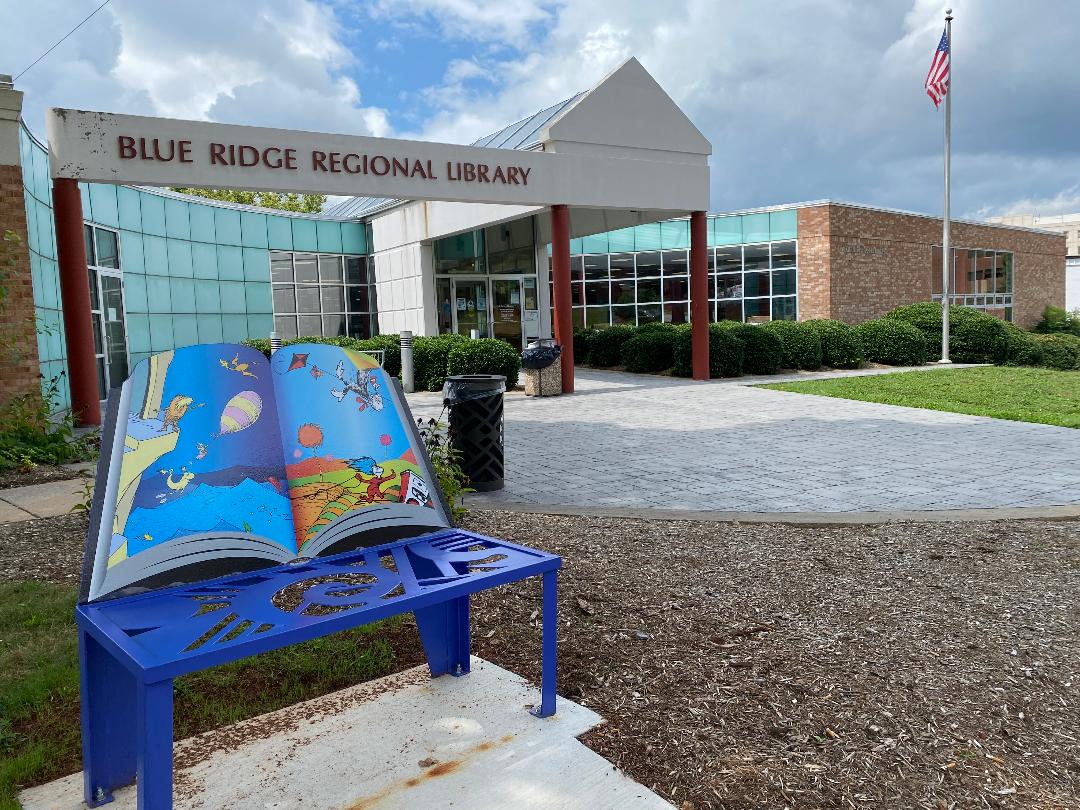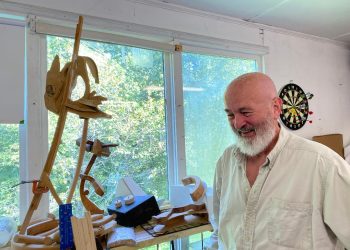
The first prototype bench, designed by Ed Dolinger and Jake Smith, is installed in front of the Blue Ridge Regional Library in Martinsville.
By Callie Hietala
Anyone driving by the Blue Ridge Regional Library in Martinsville recently might have noticed a recent addition near the front entrance. A bright blue bench, its back in the shape of an open book, with scenes from Dr. Seuss adorning the open pages. This bench is the first of several and marks the beginning of the end of a project more than a year in the making.
In January of 2020, Piedmont Arts hosted a program called AIR:Shift, developed by the AIR Institute of Berea College. According to its website, the AIR Institute “provides rural and under-resourced communities with programming that inspires new connections and ignites the creative economy. Creative people expand business skills, businesspeople get more creative; they learn to collaborate, adapt, and thrive together.”
More specifically, Shift Workshops, like the one hosted by Piedmont Arts, are three-day programs that use “hands-on collaboration, design thinking, and business planning to help grow creative communities and economies.”
Ed Dolinger, an long-time artist living in Bassett, participated in the Piedmont Arts AIR:Shift program. He recalled that participants were divided into two groups and charged with developing community-based projects that met various goals. After what he described as a delightful two days of collaboration and brainstorming, his group of seven came up with a small public art project—installing artistic benches in the community.
“Everyone assumed they’d buy generic, off-the-rack benches and artists would paint them,” Dolinger said.

Dolinger, however, was the one person in the group with public art experience. He had a different idea. Rather than just painting a prefabricated bench, artists should be able to actually design the bench, thereby making each one more unique.
The group got excited.
Dolinger said on the third day of the program, each group presented an idea to a selection committee. Judges included Piedmont Arts Director Heidi Pinkston, Martinsville Vice Mayor Jennifer Bowles, Henry County Administrator Tim Hall, and retired Lester Group executive Guy Stanley. Each group only had a few minutes to get their idea across to the judges, using whatever art forms they liked.
“We could sing about it, we could dance about it,” Dolinger said. Ultimately, his group presented a short skit. The second group, whose idea was called Move and Groove and was centered on performing arts, included dance in their presentation.
Ultimately, the judges split the $10,000 project implementation money (provided to the program by a Pick Up the Pace! grant from Harvest Foundation) between the two groups.
Just as Dolinger and his group were discussing how to move the project forward, the world was shut down by the COVID-19 pandemic.
By the summer of 2020, almost everyone in the group had moved on from the project, but Dolinger said he and Lynn Ward, one of the other group members, began work again on their own.
Because of the pandemic, the Move and Groove idea was no longer feasible, so the entire $10,000 implementation fund went toward the bench project. Dolinger spoke with other colleagues around the country for ideas, input, and suggestions. With their help, he realized that creating one of the benches and installing it would be the easiest way to explain to other artists what the project was all about.
He collaborated with Jake Smith, who has an MFA in sculpture and runs the art department at Ferrum College. Together, they came up with a base design for the benches that, while easy to replicate, will still allow individual artists to create something unique in their own style.
“We can plug anything into (this design),” Dolinger said, “which opens it up more to watercolor artists, ceramic artists. As long as you have an image that’s going to fit within a 17 x 42 format, we can digitize it” and send it off to be laser cut.
“What we’re going to offer artists is the back, the seat and, if enough of them apply, the panel in the front,” he said. That will allow for one artist to design most essential elements of the bench, or a team of artists or even a high school group to work collaboratively on various sections of each bench.
A request for proposals (RFP) was recently issued, which is the first step in finding artists to create the rest of the benches. According to the RFP, the team is looking for “visual artists, designers, and art educators in Martinsville, Henry County and adjacent counties.” Artists and art teams will be considered in two groups — those who have public art experience and those who do not. The final selections will be made by a small committee of experienced public artists and arts administrators.
“I’m excited to get to that next step,” said Dolinger.
Submission materials are due September 22, and finalists will be notified on September 27. Interested artists or groups should contact Ed Dolinger at edolinger@yahoo.com.




